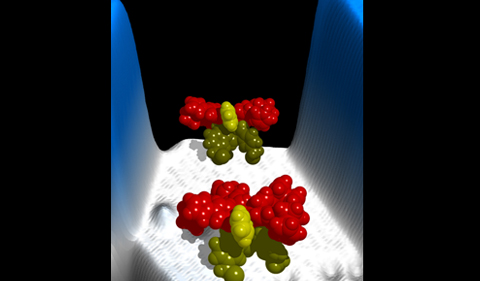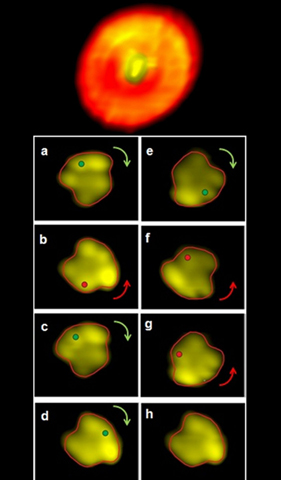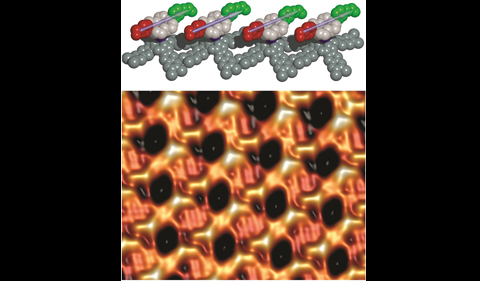
Dr. Saw-Wai Hla’s molecular machines on a surface (Image: Saw-Wai Hla, 2013)
Dr. Saw-Wai Hla, Professor of Physics & Astronomy at Ohio University and Dr. Eric Masson, Associate Professor of Chemistry & Biochemistry, are excited that the Nobel Prize awarded in Chemistry is for the development of molecular machines, a topic they research.
This year’s Chemistry Laureates—Jean-Pierre Sauvage, Sir Fraser Stoddart and Bernard Feringa—received the prize for the design and synthesis of molecules with controllable movements, which can perform a task when energy is added.
This topic strikes the same chord with the OHIO researchers who are both members of OHIO’s Nanoscale & Quantum Phenomena Institute. Hla is a leading scientist globally in the area of Scanning Tunneling Microscope manipulation of molecular motors and molecular devices on material surfaces. He has been working on molecular machines for the past 10 years and has contributed to major advances in the field.
Masson studies supramolecular and recognition chemistry and was awarded a three-year NSF grant from the Macromolecular/Supramolecular/Nanochemistry program, for his project on “Dynamic metallo-supramolecular oligomers stabilized by Cucurbit[8]uril connectors: self-assembly applied to combinatorial chemistry.”
In fact, Hla and Masson have joined efforts to take part as one of six teams in the world’s first molecular machines, or “Nanocar Race,” being organized in France in spring 2017. There they will compete against other scientists, including Nobel Chemistry Laureate Feringa, who is a member of the team from Switzerland.
Molecular Machines Research at OHIO

Scanning tunneling microscope images of controlled rotation clockwise and counter clockwise of a molecular motor (Image: Saw-Wai Hla, 2013)
Three years ago, Hla’s team demonstrated the first controlled directional rotation of molecular models on a gold crystal surface. This work—Controlled clockwise and anticlockwise rotational switching of a molecular motor—was published in Nature Nanotechnology, a multidisciplinary journal that publishes papers of the highest quality and significance in all areas of nanoscience and nanotechnology.
More recently, the Hla group—in collaboration with French colleagues—has been able to successfully introduce communication in molecular machine networks. This communication enables simultaneous rotation up to 500 molecular motors on a gold crystal surface. Their article—Simultaneous and coordinated rotational switching of all molecular rotors in a network—is published in the August 2016 issue of Nature Nanotechnology.

Molecular machines in the network communicate via dipolar interactions. This illustration shows parallel motors with dipolar rotator arms indicated by arrows. The green and red units represent negative and positive charges. (Bottom) Scanning tunneling microscope image showing a parallel arrangement of dipolar motor assembly. (Image: Saw-Wai Hla, 2016)
NanoCar Collaboration with Researchers at Argonne National Lab
At OHIO, the Masson group has already synthesized four-wheel molecular nanocars, and the Hla group is test-driving the cars. The Center for Nanoscale Materials at Argonne National Laboratory near Chicago is collaborating with the Hla group in further testing the mechanical properties of the nanocars. Hla holds a joint position at OHIO and Argonne, where he serves as the Group Leader for Quantum & Energy Materials at the center.
The Nanocar Race, originally scheduled for mid-October, has been postponed until May 2017, in order to give enough time for all teams to be ready. The postponement is essential to make the event a true “sports-science” challenge at the nanoscale (a scale that is about a billion times smaller than the Formula One race cars.) Six teams representing France, Japan, Germany, Austria, Switzerland, and the USA will compete in this world premiere event.
Read more in OHIO Research News and Forum:
- Scientists develop synchronized molecular motors, May 2016
- Masson, Hla Debut ‘Nanobobcat’ for World’s First Nanocar Race Dec 2015


















Comments